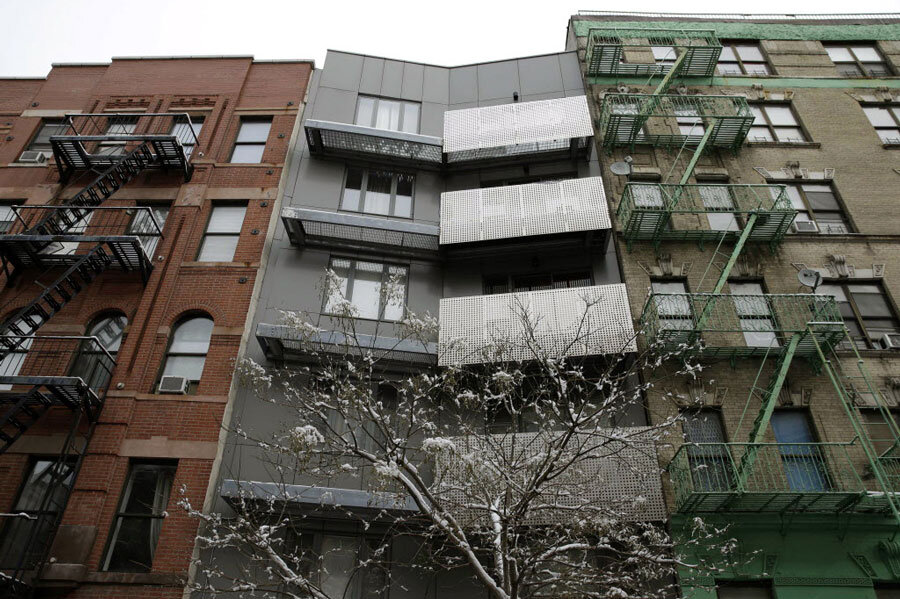Affordable housing for artists? New York mayor plans homes for creative class.
Loading...
| New York
It’s either a storied tradition or another New York City cliché: the starving artist.
But for more than a century, artists and writers have instinctively gravitated to the energy of New York and other cityscapes, with a manuscript or brush in a suitcase and a pain in his or her heart, to paraphrase E.B. White.
But the old abandoned-factories-turned-soaring-artist’s-lofts became such a cool, bohemian fantasy that the wealthy usurped them over time. New York Times columnist David Brooks memorably called them “Bobos in Paradise” – those “bourgeois bohemians” that combined capitalist values with an aesthetic of countercultural cool.
And while Manhattan’s Soho, now a sanctuary of the really-rich, won’t ever return to the now-legendary era of starving artist squatters, Mayor Bill de Blasio on Tuesday announced a new initiative to help those aspiring creative types to still find a home in New York’s not-quite-as-gritty din today.
In his second state-of-the-city address on Tuesday, Mayor de Blasio said the city would invest $30 million over the next decade to build about 150 new live/work artist spaces every year through 2024, partnering with the city’s cultural and philanthropic organizations, who would throw in $30 million more.
“We know that New York is the city it is today in part because of the contributions from generations of artistic visionaries who at one point struggled to make ends meet,” the mayor said during his address.
The city would also convert underutilized city-owned spaces into 500 below-market artist work spaces, the mayor said, an effort to create new shared cultural hubs for exhibits, performances, and art classes.
Advocates in other cities, too, have tried to carve out room for the "starving artist." In San Francisco, where a thriving tech industry has driven up rents, civic groups have tried to help artistic “hidden gems” find live/work spaces in gentrifying places like the Tenderloin district. In Nashville, private foundations recently provided $200,000 in grants to help artists find affordable housing.
Many artists have already been packing their brushes and taking their manuscripts elsewhere. Artsy magazines trumpet the “10 Cities That Creatives Should Move to That Are Not NYC or L.A.,” and they include Providence, R.I., Tuscon, Ariz., and Athens, Ga.
Last December, Brooklyn-based Galapagos Art Space, founded in 1995 and often credited for helping to revitalize its neighborhood, announced it would relocate in Detroit in 2016 – a city that has been drawing creative types for the past few years.
"We were priced out of New York," said Robert Elmes, Galapagos’s founder and executive director, according to The Detroit Free Press.
Rockers such as Patti Smith and David Byrne have decried the transformation of New York into a playground for the wealthy in which artists can’t even afford to starve anymore.
“[M]ost of Manhattan and many parts of Brooklyn are virtual walled communities, pleasure domes for the rich (which, full disclosure, includes me), and aside from those of us who managed years ago to find our niche and some means of income, there is no room for fresh creative types,” Mr. Byrne, former frontman for the Talking Heads, wrote in The Guardian in 2013. “Middle-class people can barely afford to live here anymore, so forget about emerging artists, musicians, actors, dancers, writers, journalists and small business people. Bit by bit, the resources that keep the city vibrant are being eliminated...”
But de Blasio famously said that New York was becoming a “tale of two cities” after his predecessor, Michael Bloomberg, declared the city a “luxury brand” not meant for everyone. And the current mayor is making the effort a part of public policy – and just a small part of a 10-year affordable housing plan that he’s vowing to make a centerpiece of his 2015 agenda.
"So many who live in our city struggle to afford to be here," the mayor said at the outset. “If we do not act, and act boldly, New York risks taking on the qualities of a gated community; a place defined by exclusivity rather than opportunity, and we cannot let that happen. We will not let that happen.”
But some affordable housing advocates note that the slow process of gentrification often begins with artists and musicians looking for bottom-basement rents in dilapidated neighborhoods – often the homes of low-income and minority residents.
Artists and hipsters move in, and soon coffee shops and bars open. Slowly, in a process that often takes years, the neighborhood becomes a known bohemian scene. Then the ‘bobos’ arrive, transforming the neighborhood and property values until neither the original residents or artists can afford to live there anymore – a process fully complete in once-gritty neighborhoods like Soho and Tribeca, now the neighborhoods of celebrities and the uber-rich.
The de Blasio administration, however, wants to keep the city not just a major global cultural center with its world famous institutions, but accessible on the starving artist level, too.
“We just can’t allow artists to be priced out of New York City,” said Tom Finkelpearl, commissioner of New York’s Department of Cultural Affairs, to WNYC, a local public radio station. “They’re important for the soul of the city, they’re important for neighborhoods, they’re really important for the economy.”






